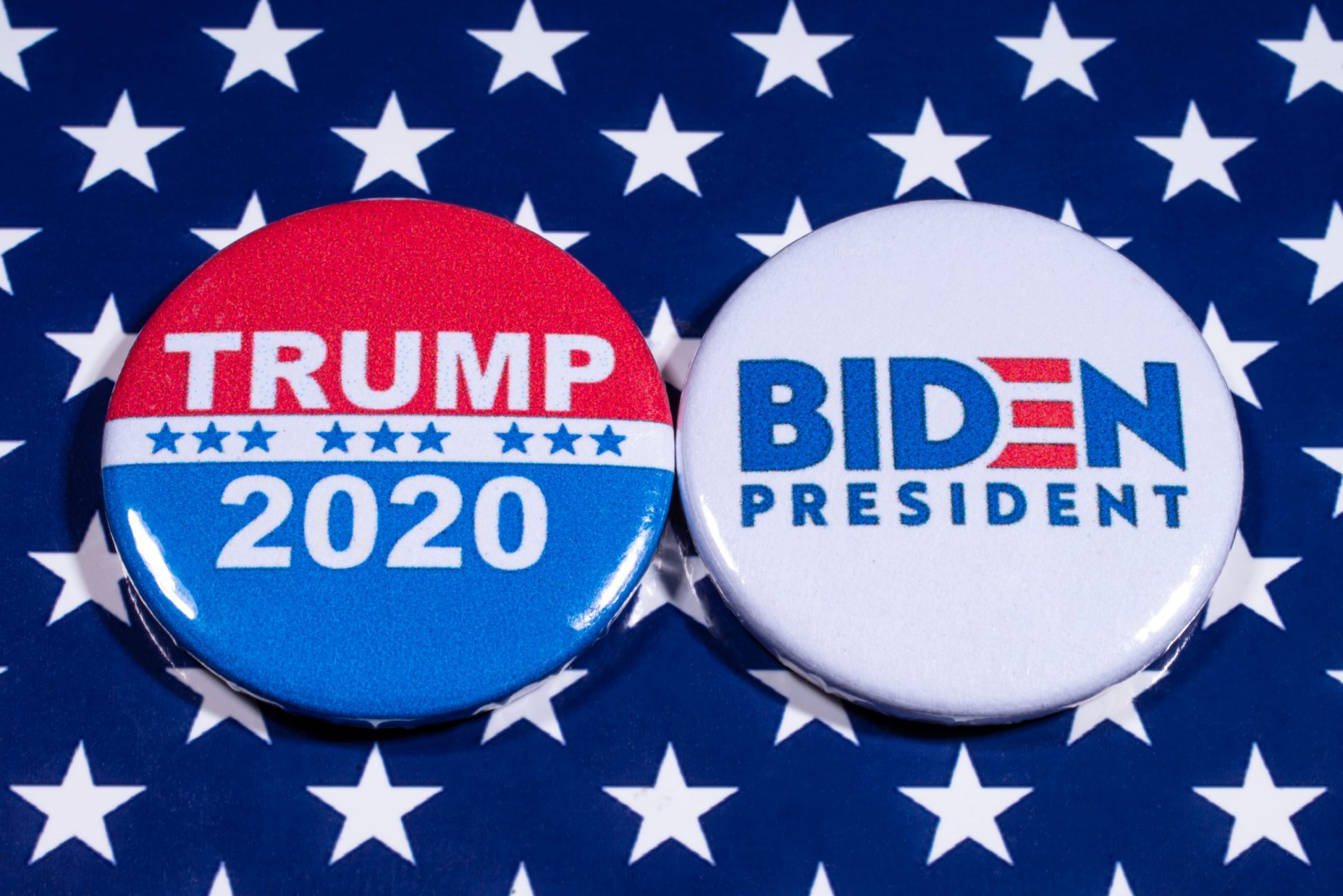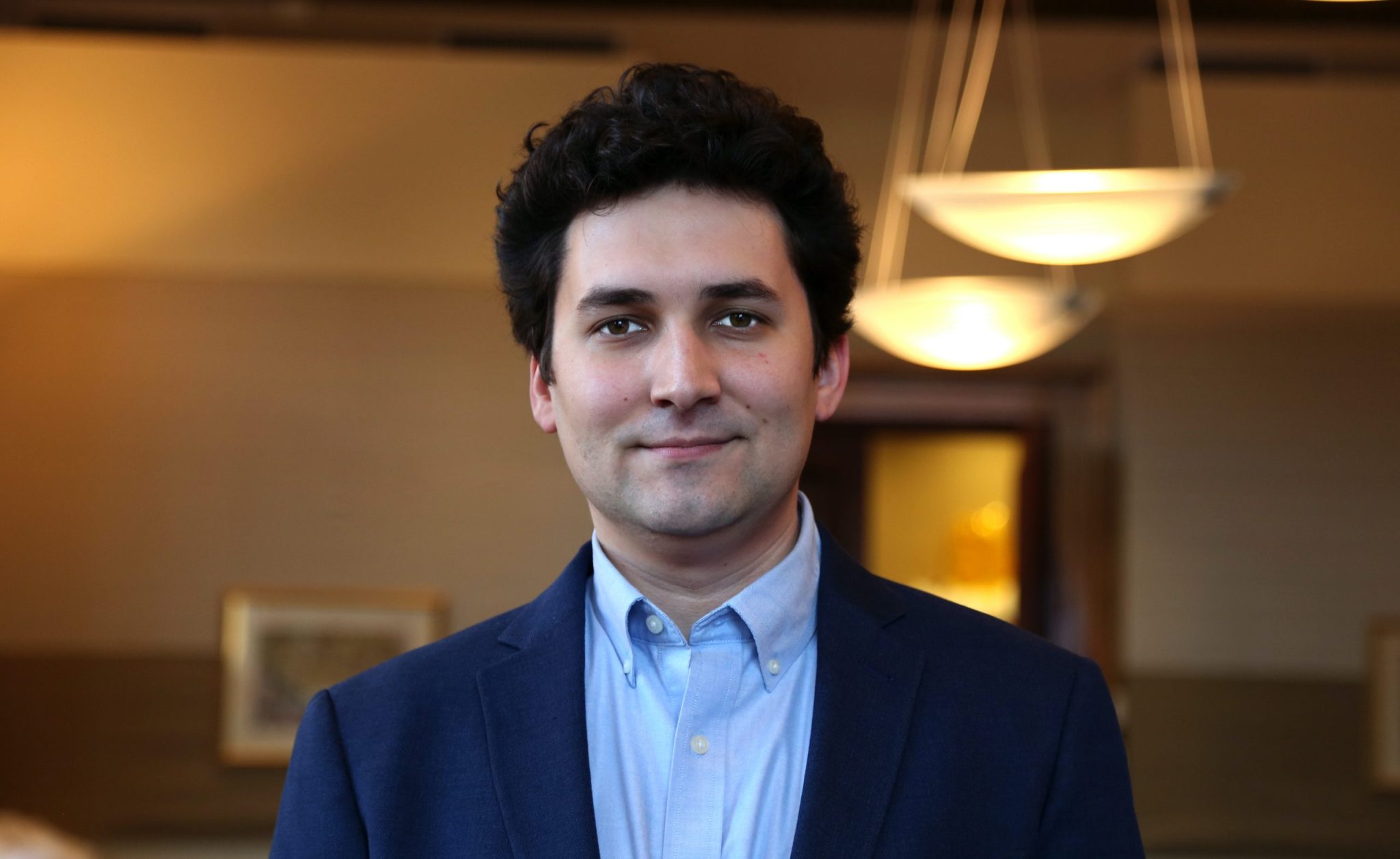Overview
On September 29, President Donald Trump and former Vice President Joe Biden sparred in the first of three (now two) presidential debates. The event, which was labelled a “debacle” and a “total disaster” by the U.S. news media, unsurprisingly provided ample fodder for Russian, Chinese, and Iranian government-controlled media outlets. While editorialized content in those outlets largely mirrored coverage more broadly, the chaotic performance was used to paint a picture of the U.S. political system as deeply dysfunctional if not irredeemable. The more civil vice presidential debate that took place on October 7 led to fewer instances of schadenfreude, but each country’s state media used the event as yet another opportunity to criticize specific candidates or, more broadly, the process itself.
By the Numbers
The first presidential debate did not register as one of the top hashtags or topics on any of the three dashboards between September 29 and October 1. However, the word “debate” was used more than 500 times by Russian, Chinese, and Iranian accounts monitored on Hamilton 2.0, with over half the uses coming from Russian accounts. (Note: While the term “debate” captured some unrelated content, the overwhelming majority of debate-related posts focused on the U.S. presidential debate). Sputnik and RT were the most active state media accounts, and RT’s debate-related coverage received the most engagement by a significant margin.
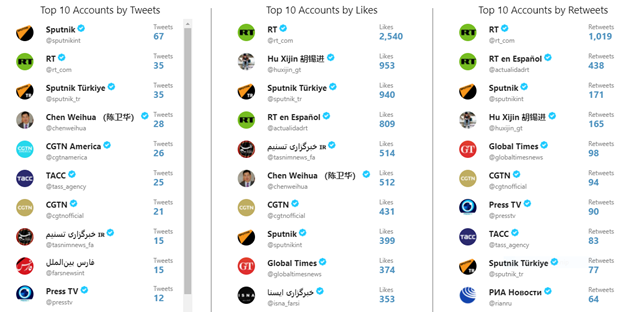
The most active, liked, and retweeted accounts mentioning the word “debate between September 29-October 1, 2020.
The vice presidential debate on October 7 saw less coverage, with the word “debate” used 317 times in tweets by monitored accounts between October 7 and October 9. Tweets mentioning debate in this period also included coverage of President Trump’s refusal to participate in a virtual debate, thus complicating efforts to isolate vice presidential debate coverage. Again, RT and Sputnik were the most active accounts tweeting about the debate, with RT receiving the most likes and retweets—though far fewer than during the presidential debate.
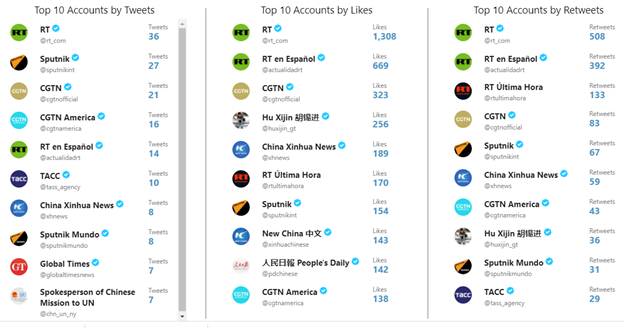
The most active, liked, and retweeted accounts mentioning the word “debate between October 7-October 9, 2020.
It is worth noting that almost all the commentary on the debates came from state media rather than diplomatic accounts, with the notable exception being comments made by Iranian President Rouhani. The most influential state media accounts from Iran and Russia were official state media accounts (for example, Sputnik and Tasnim News), while China’s most influential accounts were the personal accounts of editors associated with Chinese state media (for example, Xijin Hu and Weihua Chen).
On YouTube, RT America and RT UK posted six videos covering the presidential debate and just one covering the VP debate. CGTN America posted four videos about the presidential debate and five covering the VP debate.
On state sponsored websites, there were 118 articles mentioning with the word “debate” and “United States” between September 29-October 1 (Russian media 52 articles; Chinese media 31; Iranian media 35), compared to 76 articles referencing the VP debate (Russia 30, China, 40, Iran 6).
What We’re Seeing on Hamilton 2.0
Russian, Iranian, and Chinese state media coverage of the first U.S. presidential debate was almost universally negative, reflecting broader criticism found in U.S. and other global media outlets. Coverage of the more conventional vice presidential debate was less acerbic, with much of the negative coverage circling back to criticism of the presidential debate. Although there were commonalities in the coverage from the three monitored countries—most notably, the idea that the debates reflected a broader decline in U.S. democracy—Russia, China, and Iran’s coverage also revealed their individual preferences and messaging priorities.
Russia
Russian state media’s coverage of both debates was the most comprehensive of the state medias monitored on Hamilton 2.0, including real-time analysis of the debates. Coverage of the first presidential debate focused on four key themes: the sad state of U.S. political culture, criticism of the U.S. media, divisions in the Democratic party, and Trump’s refusal to condemn white supremacy. Analysis of the vice presidential debate played on many of the same themes, though there was a more pronounced bias in the coverage of the candidates. In addition, the issue of Russian interference—a topic discussed during the VP debate—provided an opening to hammer the United States for its alleged “Russophobia.”
Criticism of U.S. Political Culture
The chaotic nature of the presidential debate provided ample ammunition for Russia’s state media to paint the United States as unworthy of its global standing and “on the brink of a complete political and social breakdown.” This was accomplished both through quasi-serious analysis, as well as political cartoons and sarcastic gifs and memes—which are staples of Russian trolling. As per usual, memes and gifs significantly outperformed the more serious analysis.
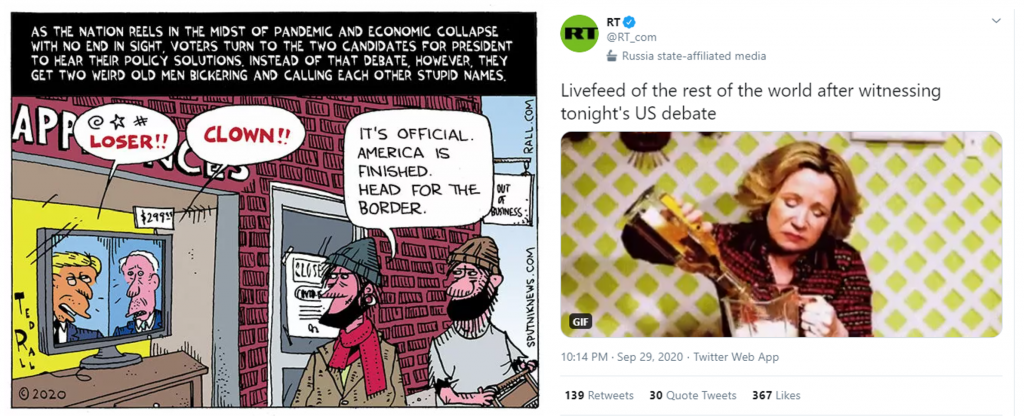
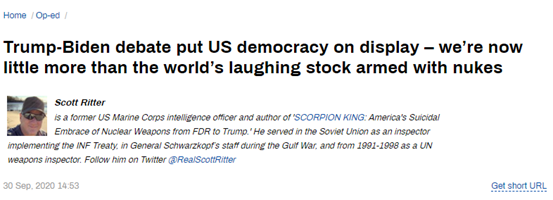
Examples of Russian state media coverage of the first presidential debate. Source (from top left to bottom): Sputnik News “Disgrace-off” September 30, 2020; Twitter @RT_com tweet from September 29, 2020; RT “Trump-Biden debate put US democracy on display – we’re now little more than the world’s laughing stock armed with nukes” September 30,2020.
The debates also provided an opportunity for Russian state media to denigrate the American political system to audiences outside the United States—including those in Russia. One RT Español headline questioned whether the United States is an “apocalyptic country” whose politics are governed by insults, while a RIA Novosti article quoted Hillary Clinton saying that she dreamed of “shutting up” Trump during their 2016 debates.
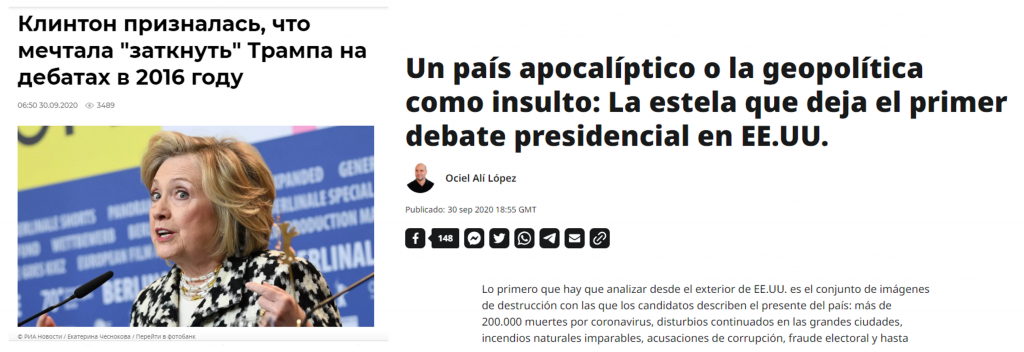
Examples of non-English language Russian state media coverage of the first presidential debate. Source (from left to right): RIA Novosti “Clinton admitted that she too dreamed of ‘shutting up’ Trump during 2016 debate” September 30, 2020; RT Espanol “An apocalyptic country of geopolitics as an insult: The wake left by the first U.S. presidential debate” September 30, 2020.
Coverage of the vice presidential debate was peppered with backhanded compliments, such as claims that the “boring” and “slow” debate shocked the world by being “vaguely civilized.” However, the debate was again presented as a farcical spectacle, this time due to the fly incident and the Biden campaign’s alleged “weaponization” of it.

Examples of Russian state media coverage of the vice presidential debate. Source (from left to right): Twitter, @RT_com post from October 8, 2020; Sputnik “Highlight of Debate Night: ‘Campaign Fly’ on Pence’s Head Steals the Show, Gets Weaponzied by Biden” October 8, 2020.
U.S. Media Criticism
A second line of attack after the first presidential debate was to blame the U.S. media, both for alleged biases in their coverage and, more broadly, for failing to uphold their duties as “guardians” of the republic. Russian state media also attacked the impartiality of fact-checking during the debate, taking specific swipes at the Biden campaign, The New York Times, and CNN—calling out the latter for its “blatant bias and lackluster fact check[s].” In both cases, RT selectively cited tweets as evidence to support its claims, a common—and deeply flawed—tactic to create the illusion of widespread public support. Attacks on fact-checkers are also a common refrain in Russian state media, in keeping with their efforts to undermine the notion of an objective truth.
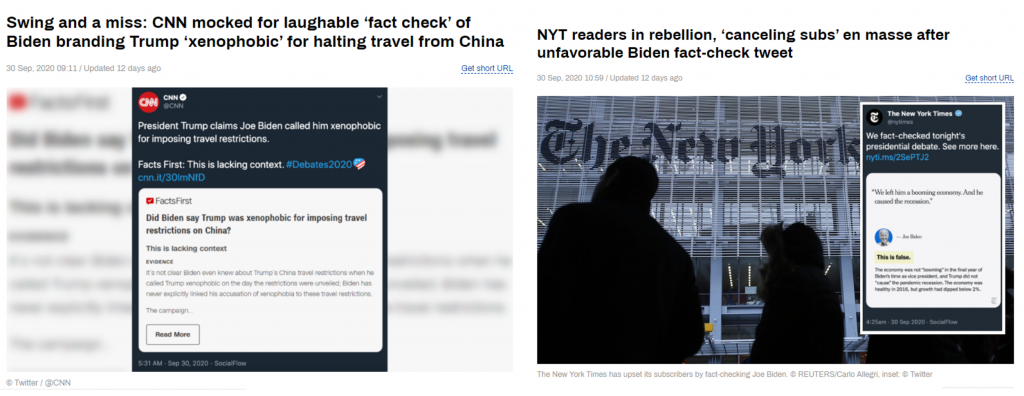
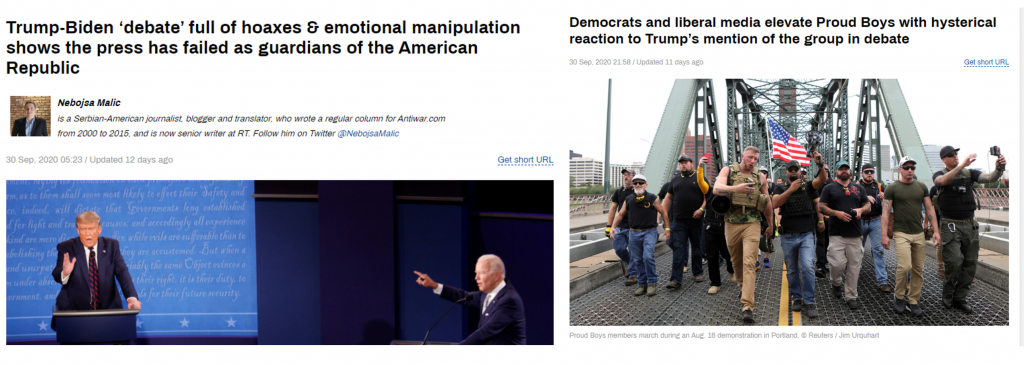
Examples of Russian state media coverage of the first presidential debate. Source (from top left to bottom right): RT “Swing and a miss: CNN mocked for laughable ‘fact-check’ of Biden branding Trump ‘xenophobic’ for halting travel from China” September 30, 2020; RT “NYT readers in rebellion, ‘cancelling subs’ en masse after unfavorable Biden fact-check tweet” September 30, 2020; RT “Trump-Biden ‘debate’ full of hoaxes and emotional manipulation shows the press has failed as guardians of the American Republic” September 30, 2020; RT “Democrats and liberal media elevate Proud Boys with hysterical reaction to Trump’s mention of the ground in debate” September 30, 2020.
The VP debate saw fewer examples of media criticism, though RT again called out the “liberal media,” this time for allegedly defending Kamala Harris. This point was emphasized in an op-ed by conservative commentator Wayne Dupree, who claimed that both debate moderators were biased against the Trump-Pence ticket.
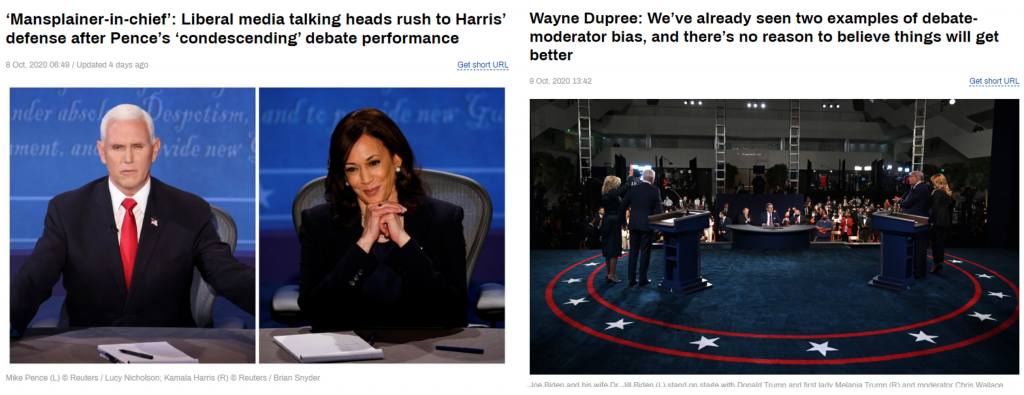
Examples of Russian state media coverage of the vice presidential debate. Source (from left to right): RT “Mainsplainer-in-chief’: Liberal media talking heads rush to Harris’ defense after Pence’s ‘condescending’ debate performance” October 8, 2020; RT “Wayne Dupree: We’ve already seen two examples of debate-moderator bias, and there’s no reason to believe things will get better” October 8, 2020.
Democratic Divisions
Real and perceived divisions between centrist and progressive Democrats were highlighted by Russian state media after both debates, which is a prominent theme dating back to at least 2016. Some of the talking points were lifted from President Trump, while others were, again, selectively pulled from the Twittersphere to create an illusion of mass resistance to the Biden-Harris ticket. After both debates, there was also amplification of third-party candidates and the promotion of content meant to frame all the candidates as unpalatable to progressives. As has been customary in commentary over the past several months, Russian media displayed an anti-Harris bias in much of its coverage.

Examples of Russian state media coverage of the presidential and vice presidential debates featuring content emphasizing splits in the Democratic Party. Source (from top left to bottom right): Sputnik “Trump says Biden dissed Bernie, threw AOC to the wolves in post-debate tweets” September 30, 2020; RT “Second Thoughts? Americans fantasize about being able to vote for Bernie Sanders” September 30, 2020; YouTube, RT America “Green Party VP nominee swipes at Dems on debate night” October 7, 2020; RT “’I am the Democratic Party,’ Biden declares, making Trump and Twitter cringe: ‘Not according to Harris’” September 30, 2020.
Trump’s Refusal to Condemn White Supremacists
In covering one of the key moments of the night, Russian state media balanced criticism of the president’s refusal to condemn white supremacy with attacks against the “liberal media” for their “hysterical reaction” to the president’s comments. This is consistent with Russia’s coverage of racial justice protests in the United States, which have threaded a needle between criticism of Trump’s rhetoric and racism in the United States and narratives meant to resonate with Trump’s supporters. This appeal to segments of the political left and right is a defining characteristic of Russian state media.
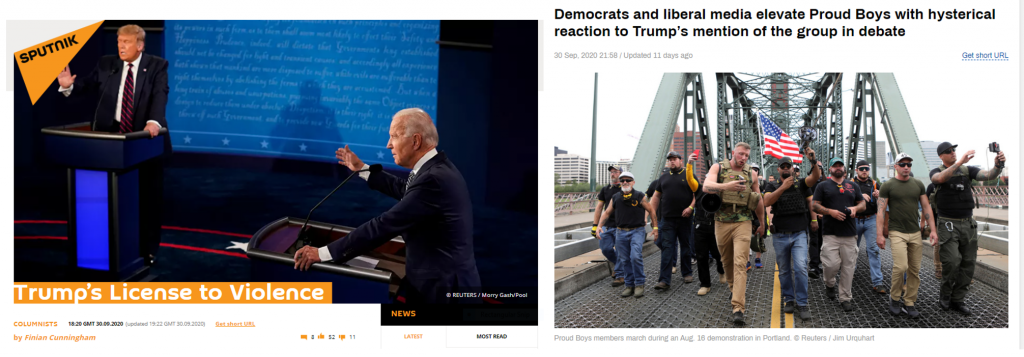
Examples of Russian state media coverage of the presidential debate featuring content about Trump’s refusal to disavow white supremacists. Source (from top left to bottom right): Sputnik “Trump’s License to Violence” September 30, 2020; RT “Democrats and liberal media elevate Proud Boys with hysterical reaction to Trump’s mention of the group in debate” September 30, 2020.
Russophobia
Finally, Russian state media’s years-long effort to cast the various investigations into Russian malign interference in 2016 as part of a “Russiagate” hoax resurfaced after Vice President Pence’s claim that the investigations were an attempt by Democrats to “overturn” the election. Unsurprisingly, RT used the opening to resurrect the idea of “anti-Russian hysteria” in Washington.
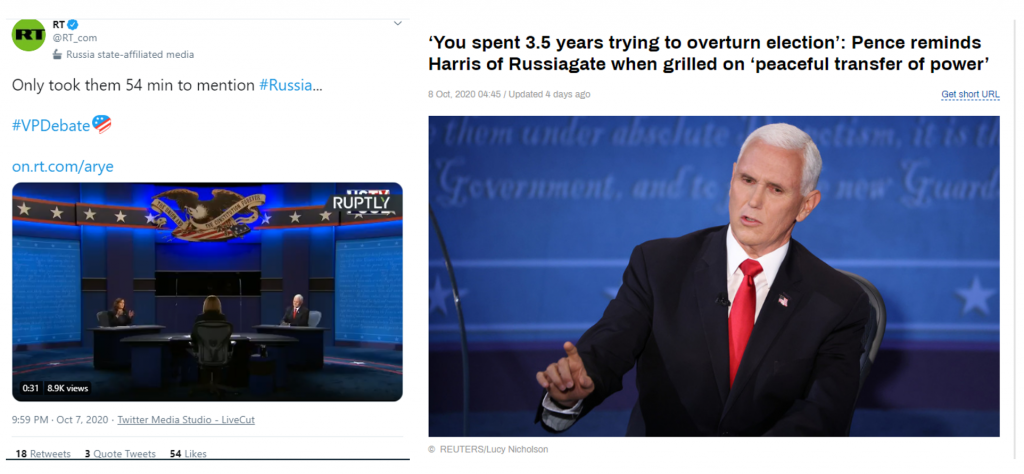
Examples of Russian state media coverage of the vice presidential debate featuring content about alleged “Russophobia” in the United States. Source (from left to right): Twitter, @RT_com post on October 7, 2020; RT “’You spent 3.5 years trying to overturn election’: Pence reminds Harris of Russiagate when grilled on ‘peaceful transfer of power’” October 8, 2020.
China
As with Russian state media’s coverage, China’s state-backed outlets slammed the first presidential debate, labelling it the “epitome of US politics” and evidence of the “recession of U.S. influence.” The most vocal critics, however, were the editors of China’s major English-language outlets, who used their personal Twitter accounts to launch a barrage of scathing commentary and sarcastic memes. Although the overall coverage was slightly more favorable to the Biden-Harris campaign, the editorialized commentary was, by and large, critical of both camps. There was also less explicit promotion of China-friendly narratives in debate coverage, save for an emphasis on comments that attacked the Trump administration’s handling of the coronavirus. Coverage of the vice presidential debate was largely factual and unremarkable, with the exception of some jabs at the fly incident.
The Debate as a Representation of the Decline of the United States
The dominant narrative from China’s state-backed outlets was that the Biden-Trump debate was unworthy of a presidential stage, as commentators likened the spectacle to a kindergarten dust-up. State media attacked both candidates’ performances, with T-House, CGTN’s opinion-arm, saying that both men were “complicit” in the problems facing the United States and that neither offered “a real path forward.” On CGTN America, a television outlet typically measured in its critique of U.S. domestic issues, commentators labelled the debate “an embarrassment” that would do “permanent damage to whoever winds up being the winner.” And CGTN’s written analysis of the debate summed up the contest with the headline “Trump-Biden: Messy debate features anger, controversy and few winners.”

Examples of Chinese state media coverage of the presidential debate. Source (from left to right): Twitter, @shen_shiwei post on September 30, 2020; Twitter, @thouse_opinion post on September 30, 2020.
The sharpest elbows, however, were thrown by editors and reporters at CGTN, China Daily, and Global Times, who used their Twitter accounts to frame the debate as evidence of the “loss of advantages of the US political system.” Weihua Chen, the bombastic deputy editor of China Daily, amplified a story about Americans searching Google for ways to move to Canada (Russian state media also promoted this story), and highlighted the candidates’ inability to follow the debate rules. And Qingqing Chen, a reporter at Global Times, shared purported sentiments from Chinese audiences who she claimed tuned in to watch the debate because both candidates are “idiots.”

Examples of Chinese state media coverage of the presidential debate. Source (from left to right): Twitter, @HuXijin_GT post on September 29, 2020; Twitter, @qingqingparis post on September 29, 2020.
Coverage of the vice presidential debate was less critical, with Xinhua calling it “less rancorous” and People’s Daily labelling it “a largely civil debate.” The VP debate coverage did, however, highlight Senator Harris’ criticism of the Trump administration’s handling of the coronavirus, a common refrain in Chinese state media outputs. Most of the commentary, though, factually reported Harris’ comments without editorial spin.
Iran
Iran’s coverage of the two debates was the least comprehensive of the three monitored countries and received significantly less engagement than China or Russia’s outputs. At the narrative level, Iranian state media largely echoed the themes present in Russian and Chinese state media: namely, that the debate was not only “a debacle” but also a reflection of the United States’ diminished standing in the world. But Iranian accounts and outlets also focused, unsurprisingly, on issues that touched on Iran’s core interests, primarily the U.S. withdrawal from the Iran nuclear deal. Iran was unique, however, in that its diplomats and government officials, including President Rouhani, did not shy away from directly criticizing the debates—something Chinese and Russian government officials largely avoided.
The United States as the Ultimate Loser of the Debate
Similar to Russian and Chinese state media outlets, Iranian state media framed the event as a clear indication of the decay of the United States’ political system. This message was also advanced by President Rouhani, who publicly stated that the debate “showed America is entangled in a difficult situation in both domestic and foreign spheres.” Rouhani was the only major government official from Iran, Russia, or China to comment publicly on the debates.
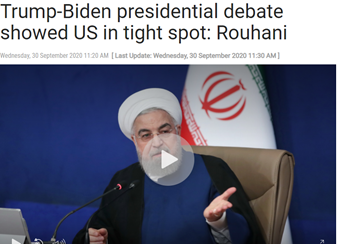
Source: PressTV, “Trump-Biden presidential debate showed US in tight spot: Rouhani” September 30, 2020.
Iranian coverage was hyper-critical of both candidates, including suggestions that “Trump was not the only clown on the stage.” Coverage of Biden asserted that the former vice president would not offer the United States an alternative path and that he is unfit for the job:
“Biden looked terrible to the world’s eyes – he could not master himself, nor master the situation. He is not much of a leader – that is the best-case scenario. Contrarily, as I assert, Biden decided to copy Trump’s behavior because he saw that Trumpian buffoonery gets one elected.”
Source: PressTV, “US debate debacle shows Democrats will adopt Trumpian self-interest globally” October 1, 2020
But, as with Russian and Chinese outputs, the primary narrative was that the debate was a reflection of a decline in U.S. influence at home and abroad. PressTV claimed that the “debate had no winner, America lost,” while IRNA cited CNN’s analysis that Americans were the “biggest losers of the presidential debate.”
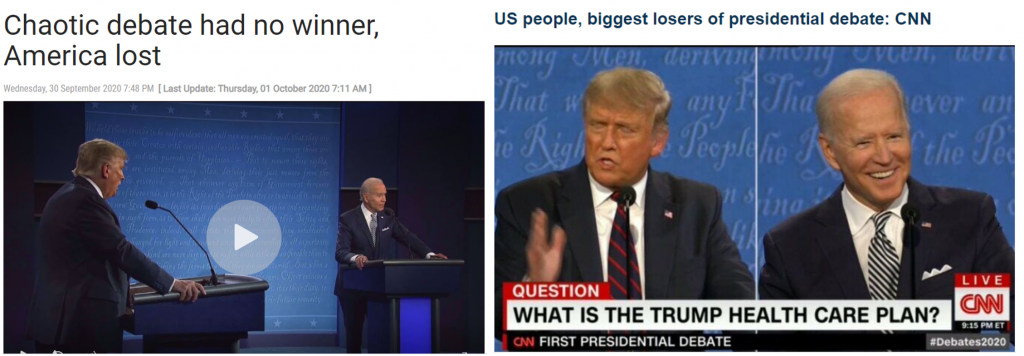
Source: PressTV, “Chaotic debate had no winner, America lost” September 30, 2020; IRAN, “US people, biggest losers of presidential debate: CNN” September 30, 2020.
U.S. Withdrawal from the Iran Nuclear Deal
Although the vice presidential debate saw significantly less coverage than the presidential debate, Kamala Harris’ criticism of the Trump administration’s withdrawal from the Iran nuclear deal was amplified by several Iranian outlets. Those outlets also noted the discussion of the assassination of Qasim Soleimani and the Iranian counter-attack that wounded several American troops.



Source: Hamilton 2.0 examples of Iranian state media tweets referencing the vice presidential debates. Snapshot taken on October 8, 2020.
Why It Matters
The uncivil and chaotic first presidential debate provided Russia, China, and Iran with an easy opportunity to cast the U.S. political system as deeply dysfunctional and unpalatable to audiences at home and abroad. While there was some hyperbole and bias in each countries’ coverage, none of the three countries engaged in outright mis- or disinformation in their reporting—probably because there was no need to. In fact, most of the coverage largely echoed, and indeed sometimes directly quoted, coverage in U.S. and other western media outlets. The collective debate coverage is yet another reminder that the United States’ social and political ills are increasingly being weaponized by its adversaries—often without the need for much editorial spin, let alone outright falsehoods.
The views expressed in GMF publications and commentary are the views of the author alone.

